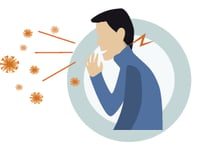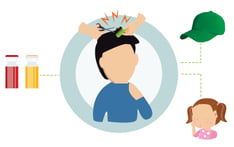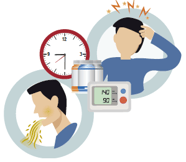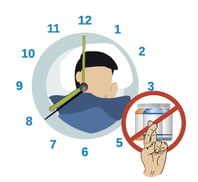 In this case, we present an incredible day-by-day progression from the moment of onset of a vertebral artery dissection as told by the emergency physician
In this case, we present an incredible day-by-day progression from the moment of onset of a vertebral artery dissection as told by the emergency physician
who had it!
Vertebrobasilar artery thrombosis or dissection affecting the posterior circulation can be extraordinarily difficult to diagnose. In the failure to diagnose specialties such as
primary care, internal medicine, family practice, emergency medicine and urgent care where the door is open to all, risk and safety education and evaluation focused around this deadly high-risk clinical entity is critical.
The TSG Mission is to reduce the failure to diagnose medical errors and improve patient safety. This seems like a tall order, but it is absolutely manageable as we have demonstrated with several large organizations in the United States over the last 20 years. The key is to understand cause and effect at the most granular level and then build education and other cognitive tools to avoid
the failure to diagnose.
 In the case of vertebral artery disease, symptoms may be minimal or severe. Symptoms run the gamut from vertigo, nausea and vomiting, changes in level of consciousness, headache, and speech disturbance as well as obvious severe neurologic deficits. The practitioner seeing a patient with vertigo commonly anchors on inner ear disease; a patient presenting with nausea and vomiting may have a wide range of disorders; and the patient with an isolated headache is always a diagnostic dilemma. Vertebral arterial disease may simply not be in the differential diagnosis for any of these patients. When the presentation is subtle, the only way to arrive at a correct diagnosis is to know when to consider vertebral artery disease in the differential diagnosis. When should the red flag go up for consideration of this deadly disorder?
In the case of vertebral artery disease, symptoms may be minimal or severe. Symptoms run the gamut from vertigo, nausea and vomiting, changes in level of consciousness, headache, and speech disturbance as well as obvious severe neurologic deficits. The practitioner seeing a patient with vertigo commonly anchors on inner ear disease; a patient presenting with nausea and vomiting may have a wide range of disorders; and the patient with an isolated headache is always a diagnostic dilemma. Vertebral arterial disease may simply not be in the differential diagnosis for any of these patients. When the presentation is subtle, the only way to arrive at a correct diagnosis is to know when to consider vertebral artery disease in the differential diagnosis. When should the red flag go up for consideration of this deadly disorder?
That said, I gave a presentation on vertebrobasilar artery disease and posterior circulation deficits at a recent American College of Emergency Physicians Scientific Assembly. During that meeting, an emergency physician approached me after the presentation and mentioned that he actually had a vertebral artery dissection. It is one thing to look at litigation in retrospect; it is quite another to get a first-hand account of the day-to-day symptom progression of a disorder from a practicing emergency physician! Here is that physician’s story.
Case Presentation
To start – I have no known medical issues and don’t take any daily prescribed medications. No significant family history.
The previous week
 Previously healthy. 1yo daughter just started daycare and developed a URI, which was passed to me. I was coughing pretty hard. At one point, felt a “twinge” on the left side of my neck. It didn’t hurt, but from then on, I noticed that I would reflexively hold my neck when I coughed. Still, no pain or other symptoms. I was started on Tesselon Perles and albuterol and also was using Mucinex and Dylsum for symptoms, which helped a little. (As an aside, Pertussis was later sent but not back yet).
Previously healthy. 1yo daughter just started daycare and developed a URI, which was passed to me. I was coughing pretty hard. At one point, felt a “twinge” on the left side of my neck. It didn’t hurt, but from then on, I noticed that I would reflexively hold my neck when I coughed. Still, no pain or other symptoms. I was started on Tesselon Perles and albuterol and also was using Mucinex and Dylsum for symptoms, which helped a little. (As an aside, Pertussis was later sent but not back yet).
Tuesday of this week
At some point during the day, noticed a posterior neck pain, but mostly point tenderness at the base of the skull right along the lymph nodes. Pushing on that spot would cause a parietal headache, which would improve when I stopped pushing. I also noted some pretty significant hyperesthesia of the scalp (like a sunburn) that started on the forehead just below hairline to the parietal region. I never get headaches and did comment on the fact that this was a weird one to a coworker that day. I took Tylenol, Motrin and then later Robaxin, which did not provide any relief. However, lying on my side (either right or left), the pain would resolve. Both heat and ice also helped. I did notice during dinner that day that the sniffing position was very uncomfortable for me. No neuro symptoms. No dizziness.
Wednesday
 Went to get a haircut and noticed that the pain when the comb touched my scalp was pretty impressive. Also wearing a baseball cap was very painful (yes, I know, over 30 shouldn’t wear baseball caps!). So I started thinking more zoster. Since I had a wedding to go to on Saturday and this still seemed pretty benign, I started taking Valtrex and Prednisone in case this was early shingles. Couldn’t explain the neck pain, but the rest made sense. Also, that day my daughter developed what was probably a delayed allergic reaction to amoxicillin (this is an important point for later).
Went to get a haircut and noticed that the pain when the comb touched my scalp was pretty impressive. Also wearing a baseball cap was very painful (yes, I know, over 30 shouldn’t wear baseball caps!). So I started thinking more zoster. Since I had a wedding to go to on Saturday and this still seemed pretty benign, I started taking Valtrex and Prednisone in case this was early shingles. Couldn’t explain the neck pain, but the rest made sense. Also, that day my daughter developed what was probably a delayed allergic reaction to amoxicillin (this is an important point for later).
Thursday
That night, still tossing and turning due to pain but still felt OK when on my side. However, standing would now lead to a more mild but persistent parietal (pre-orbital) headache. We were supposed to be on a plane that AM to Hawaii for the wedding, but since the little one was up all night with her itching, we decided to postpone for a day. During the day, the headache became more persistent, but still no neuro symptoms. No relief with OTC meds. Ice was helping a bit less. Almost went to the ED, but since it still seemed pretty clearly muscular (or maybe neuralgia-y), figured that CT wouldn’t be indicated. However, with no rash yet, dissection was now at least being considered.
Friday
 Woke up feeling pretty good, but then symptoms returned when I got up to go downstairs for breakfast. Took 2 Excedrin, mostly for the caffeine but also fortunately got my ASA too. The thing that concerned my wife was that we needed to be in the car in 15 minutes and I apparently laid back down in the bed because that felt better. So we get out the door (probably didn’t do myself any favors lugging her 75lb bag into the back of the car) and are on the freeway and I have an ice pack to my neck and seeming pretty miserable. So we decided that in the off chance it WAS a dissection (since no zoster rash), best to get checked out so I don’t need TPA when we land in Honolulu (although I was later told they have some great neuro care there!) We then delayed the flight again and turned around and headed to the Emergency Department. (Did I mention that my parents were already in the hotel in Hawaii waiting for us?)
Woke up feeling pretty good, but then symptoms returned when I got up to go downstairs for breakfast. Took 2 Excedrin, mostly for the caffeine but also fortunately got my ASA too. The thing that concerned my wife was that we needed to be in the car in 15 minutes and I apparently laid back down in the bed because that felt better. So we get out the door (probably didn’t do myself any favors lugging her 75lb bag into the back of the car) and are on the freeway and I have an ice pack to my neck and seeming pretty miserable. So we decided that in the off chance it WAS a dissection (since no zoster rash), best to get checked out so I don’t need TPA when we land in Honolulu (although I was later told they have some great neuro care there!) We then delayed the flight again and turned around and headed to the Emergency Department. (Did I mention that my parents were already in the hotel in Hawaii waiting for us?)
Get to the ED and was examined. Everyone felt that this was muscular. Even had a nice tender point right on the back of my neck. So decided to try a trigger point injection, figuring if that helped, end of story. Unfortunately, it didn’t help, so we got a CT/CTA, mostly to make me and my wife feel ok about flying later that day. CTA showed a long segment left VAD without intracranial extension and no thrombosis. So since I was still coughing and now NPO for possible angiogram, I got 2mg of MS for the cough (which helped) and I was admitted to the Neuro ICU.
Got a transcranial Doppler, which showed no emboli, and an MRI/A head, which showed no CVA (and surprisingly little white matter disease). Noted my BP was 160s/110s, which was left alone. IM/NS/Neuro decided to skip the angio and start me on ASA/Plavix for 6 weeks. Also Lisinopril if my BP didn’t get more reasonable, and Lipitor. Coumadin considered but not favored by this group. Mentioned that they don’t use the novel anticoagulants. They also mentioned “sacrificing” the artery could be an option … which I’d rather not do since there may come a day that I need that one … like when I cough my right one into dissecting.
Did well that day, but then made the mistake of accepting Norco, which I promptly vomited (along with some soup) … apparently vomiting is frowned upon with VADs. Slept very poorly that night.
Yesterday
 Worse HA in the morning, and BP was still up, so more pain meds/nausea meds and Lisinopril trying to get it to 140s/90s, which we ultimately achieved in the afternoon. Discharged home. Lots of traffic (shocking). Got car sick right at our exit and then proceeded to vomit some more (despite Reglan before leaving). This led to a significant increase in headache, which was now almost all preorbital and not relieved with position and ice. I took some Zofran and Tramadol, which did not help, so headed over to the Issy ED at about 9:30pm. Took about 2½ liters of NS, IV/PO Dilaudid, Zofran, IV Compazine, IV Benadryl and IV Ativan and about 8 hours to get symptoms back under control enough to go home. Repeat CTA showed no change in the dissection.
Worse HA in the morning, and BP was still up, so more pain meds/nausea meds and Lisinopril trying to get it to 140s/90s, which we ultimately achieved in the afternoon. Discharged home. Lots of traffic (shocking). Got car sick right at our exit and then proceeded to vomit some more (despite Reglan before leaving). This led to a significant increase in headache, which was now almost all preorbital and not relieved with position and ice. I took some Zofran and Tramadol, which did not help, so headed over to the Issy ED at about 9:30pm. Took about 2½ liters of NS, IV/PO Dilaudid, Zofran, IV Compazine, IV Benadryl and IV Ativan and about 8 hours to get symptoms back under control enough to go home. Repeat CTA showed no change in the dissection.
Today
 Slept for 8 hours. Woke up with only mild neck pain. No nausea. BP normal so no Lisinopril and have not needed pain meds/antiemetics. So fingers crossed.
Slept for 8 hours. Woke up with only mild neck pain. No nausea. BP normal so no Lisinopril and have not needed pain meds/antiemetics. So fingers crossed.
Plan is to lay low for 6 weeks and get a repeat CTA. If things are better, back to normal.
So yes, very odd. I still don’t think that the original CTA was indicated and there really wasn’t a good reason for the dissection in the first place. I’m curious to hear any thoughts about this. I know that I for one will unfortunately probably order more of these tests for weird symptoms without a definite clear cause.
Case Review
Well that’s scary! This individual had no apparent risk factor or predisposition, and the dissection apparently started with a cough. Medicine will never be an “exact” science, and sometimes there is simply not a good explanation for a clinical presentation; but it is fascinating to hear this practitioner’s day-by-day explanation of the evolution of his dissection.
Was there an indication for a CT? Even in his own case, this doc felt that the day the scan was done, it was only for reassurance and without a clinical indication. All involved felt this was musculoskeletal. But was there enough to raise the red flag for further diagnostics?
He never had headaches before. His symptoms were: posterior neck pain, parietal headache, scalp hyperesthesia (forehead to parietal), sniffing position uncomfortable, scalp pain, and later persistent parietal and pre-orbital headache. Headaches were never described as severe or thunderclap, and there were no neurologic deficits.
How to evaluate this case?
There is no vertebral artery dissection rule. No thrombosis guideline. Perhaps we should consider the neck pain and headache. Let’s run his symptoms against the Ottawa Subarachnoid Hemorrhage Rule for Headache Evaluation. He would score a 1 for “Neck Pain or Stiffness.” The Rule tells us: “This patient cannot be ruled out for subarachnoid hemorrhage by the Ottawa SAH Rule.”
Let’s run the presentation by the MIPS/MACRA measure #419, Overuse of Neuroimaging for Patients with Primary Headache. The measure suggests that CT not be performed unless:
 “Documentation of Medical reason(s) for ordering an advanced brain imaging study (i.e., patient has an abnormal neurological examination; patient has the coexistence of seizures, or both; recent onset of severe headache; change in the type of headache; signs of increased intracranial pressure (e.g., papilledema, absent venous pulsations on funduscopic examination, altered mental status, focal neurologic deficits, signs of meningeal irritation); HIV-positive patients with a new type of headache; immunocompromised patient with unexplained headache symptoms; patient on coagulopathy/anti-coagulation or anti-platelet therapy; very young patients with unexplained headache symptoms).”
“Documentation of Medical reason(s) for ordering an advanced brain imaging study (i.e., patient has an abnormal neurological examination; patient has the coexistence of seizures, or both; recent onset of severe headache; change in the type of headache; signs of increased intracranial pressure (e.g., papilledema, absent venous pulsations on funduscopic examination, altered mental status, focal neurologic deficits, signs of meningeal irritation); HIV-positive patients with a new type of headache; immunocompromised patient with unexplained headache symptoms; patient on coagulopathy/anti-coagulation or anti-platelet therapy; very young patients with unexplained headache symptoms).”
“Very young” is not defined, but this practitioner was relatively young with unexplained headache symptoms. Interestingly, this case would probably fail the MACRA or PQRS quality measure for CT utilization in primary headache.
So what’s the answer? Does the evidence point us in a particular direction? There is certainly nothing definitive. The answer is that these guidelines and rules are just that - guideposts. They often don’t fit a particular clinical encounter, and ultimately we rely on clinical judgment. In this case, the symptom constellation was very unusual in an otherwise very healthy young man. It absolutely pointed to the central neurologic system, and CT/CTA seems completely reasonable and perhaps life-saving in this case.
The bottom line - good outcome, health emergency physician, and an incredibly interesting recount of the onset and progression of a vertebral artery dissection. I hope there is a pearl in this story that positively impacts your clinical practice.
As always, we are interested in your thoughts and comments.
Have you experienced an interesting case recently? Share with The Sullivan Group and we'll review for potential future inclusion in our Clinicians Corner.


